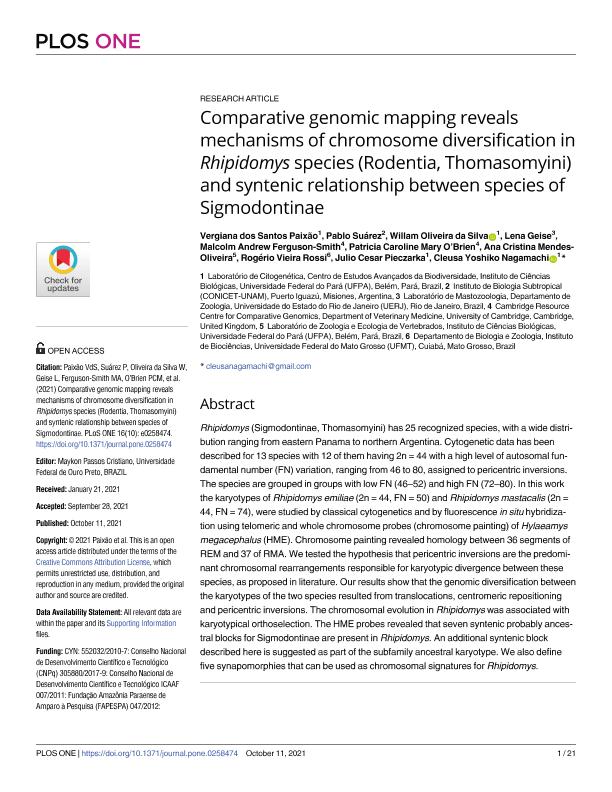Mostrar el registro sencillo del ítem
dc.contributor.author
Dos Santos Paixão, Vergiana
dc.contributor.author
Suarez, Pablo

dc.contributor.author
Oliveira da Silva, Willam
dc.contributor.author
Geise, Lena
dc.contributor.author
Ferguson Smith, Malcolm Andrew
dc.contributor.author
Mary O’Brien, Patricia Caroline
dc.contributor.author
Mendes Oliveira, Ana Cristina
dc.contributor.author
Vieira Rossi, Rogério
dc.contributor.author
Pieczarka, Julio Cesar
dc.contributor.author
Nagamachi, Cleusa Yoshiko
dc.date.available
2022-04-22T13:51:26Z
dc.date.issued
2021-10
dc.identifier.citation
Dos Santos Paixão, Vergiana; Suarez, Pablo; Oliveira da Silva, Willam; Geise, Lena ; Ferguson Smith, Malcolm Andrew; et al.; Comparative genomic mapping reveals mechanisms of chromosome diversification in Rhipidomys species (Rodentia, Thomasomyini) and syntenic relationship between species of Sigmodontinae; Public Library of Science; Plos One; 10-2021; 1-21
dc.identifier.issn
1932-6203
dc.identifier.uri
http://hdl.handle.net/11336/155540
dc.description.abstract
Rhipidomys (Sigmodontinae, Thomasomyini) has 25 recognized species, with a wide distribution ranging from eastern Panama to northern Argentina. Cytogenetic data has been described for 13 species with 12 of them having 2n = 44 with a high level of autosomal fundamental number (FN) variation, ranging from 46 to 80, assigned to pericentric inversions. The species are grouped in groups with low FN (46-52) and high FN (72-80). In this work the karyotypes of Rhipidomys emiliae (2n = 44, FN = 50) and Rhipidomys mastacalis (2n = 44, FN = 74), were studied by classical cytogenetics and by fluorescence in situ hybridization using telomeric and whole chromosome probes (chromosome painting) of Hylaeamys megacephalus (HME). Chromosome painting revealed homology between 36 segments of REM and 37 of RMA. We tested the hypothesis that pericentric inversions are the predominant chromosomal rearrangements responsible for karyotypic divergence between these species, as proposed in literature. Our results show that the genomic diversification between the karyotypes of the two species resulted from translocations, centromeric repositioning and pericentric inversions. The chromosomal evolution in Rhipidomys was associatedwith karyotypical orthoselection. The HME probes revealed that seven syntenic probably ancestral blocks for Sigmodontinae are present in Rhipidomys. An additional syntenic block described here is suggested as part of the subfamily ancestral karyotype. We also define five synapomorphies that can be used as chromosomal signatures for Rhipidomys.
dc.format
application/pdf
dc.language.iso
eng
dc.publisher
Public Library of Science

dc.rights
info:eu-repo/semantics/openAccess
dc.rights.uri
https://creativecommons.org/licenses/by/2.5/ar/
dc.subject
SMALL TREE RATS
dc.subject
AMAZON RAINFOREST
dc.subject
ATLANTIC FOREST
dc.subject
CHROMOSOME PAINTING
dc.subject
CHROMOSOMAL SYNAPOMORPHIES
dc.subject.classification
Genética y Herencia

dc.subject.classification
Ciencias Biológicas

dc.subject.classification
CIENCIAS NATURALES Y EXACTAS

dc.subject.classification
Zoología, Ornitología, Entomología, Etología

dc.subject.classification
Ciencias Biológicas

dc.subject.classification
CIENCIAS NATURALES Y EXACTAS

dc.title
Comparative genomic mapping reveals mechanisms of chromosome diversification in Rhipidomys species (Rodentia, Thomasomyini) and syntenic relationship between species of Sigmodontinae
dc.type
info:eu-repo/semantics/article
dc.type
info:ar-repo/semantics/artículo
dc.type
info:eu-repo/semantics/publishedVersion
dc.date.updated
2022-03-29T19:02:48Z
dc.journal.pagination
1-21
dc.journal.pais
Estados Unidos

dc.journal.ciudad
San Francisco
dc.description.fil
Fil: Dos Santos Paixão, Vergiana. Universidade Federal do Pará; Brasil
dc.description.fil
Fil: Suarez, Pablo. Consejo Nacional de Investigaciones Científicas y Técnicas. Centro Científico Tecnológico Conicet - Nordeste. Instituto de Biología Subtropical. Instituto de Biología Subtropical - Nodo Puerto Iguazú | Universidad Nacional de Misiones. Instituto de Biología Subtropical. Instituto de Biología Subtropical - Nodo Puerto Iguazú; Argentina
dc.description.fil
Fil: Oliveira da Silva, Willam. Universidade Federal do Pará; Brasil
dc.description.fil
Fil: Geise, Lena. Universidade do Estado de Rio do Janeiro; Brasil
dc.description.fil
Fil: Ferguson Smith, Malcolm Andrew. Cambridge Resource Centre For Comparative Genomics; Reino Unido
dc.description.fil
Fil: Mary O’Brien, Patricia Caroline. University of Cambridge; Reino Unido
dc.description.fil
Fil: Mendes Oliveira, Ana Cristina. Universidade Federal do Pará; Brasil
dc.description.fil
Fil: Vieira Rossi, Rogério. Universidade Federal do Mato Grosso do Sul; Brasil
dc.description.fil
Fil: Pieczarka, Julio Cesar. Universidade Federal do Pará; Brasil
dc.description.fil
Fil: Nagamachi, Cleusa Yoshiko. Universidade Federal do Pará; Brasil
dc.journal.title
Plos One

dc.relation.alternativeid
info:eu-repo/semantics/altIdentifier/url/https://journals.plos.org/plosone/article?id=10.1371/journal.pone.0258474
dc.relation.alternativeid
info:eu-repo/semantics/altIdentifier/doi/https://doi.org/10.1371/journal.pone.0258474
Archivos asociados
